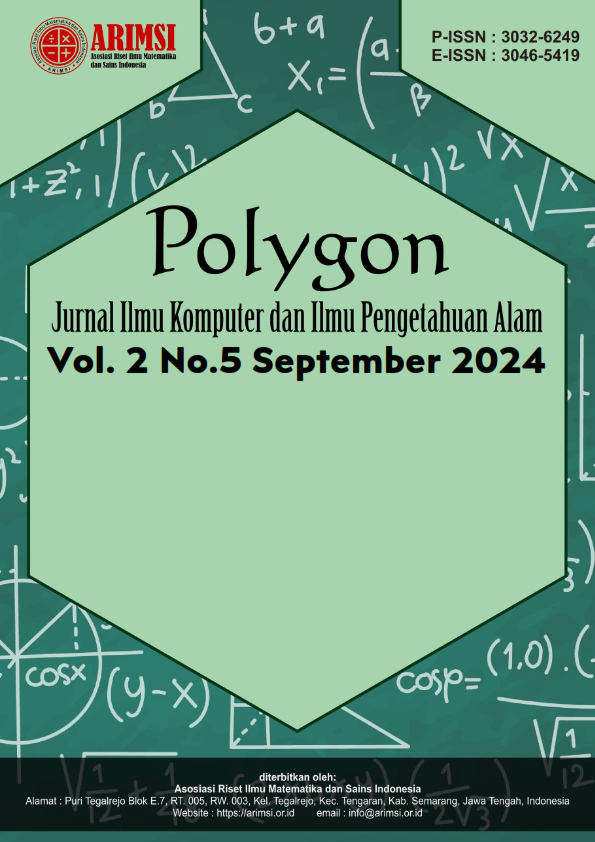Perbandingan Aktivasi Otot Trisep pada Kondisi Kontraksi dan Relaksasi Menggunakan Elektromiografi (EMG) Portabel Berbasis Android
DOI:
https://doi.org/10.62383/polygon.v2i5.234Keywords:
Electromyography (EMG), BLYNK, Ticep MuscleAbstract
EMG is a method widely used to estimate muscle activity and can help understand how muscles interact with each other that affects human movement control. In this study to detect muscle interaction during contraction and relaxation of the triceps elbow muscle. Non-invasive techniques are used in this study to characterize muscle electrical activity. In this study, additional loads were added to the contraction movement to observe whether there was a relationship between changes in muscle activity and the load carried by the muscle in male and female subjects. Signal changes can be read by the microcontroller ADC and then sent to Blynk. This study shows that during the relaxation movement, the subject has an average Vpp value of 0.007 V. When performing the contraction movement, the average Vpp value increases to 0.024 V. When a 2 kg load is added, the average Vpp value increases to 0.027 V. The heavier the load carried, the Vpp value of muscle activity also increases.
Downloads
References
A. W. Shehata, H. E. Williams, J. S. Hebert, & P. M. Pilarski. (2021). Machine learning for the control of prosthetic arms: Using electromyographic signals for improved performance. IEEE Signal Processing Magazine, 38(4), 46–53. https://doi.org/10.1109/MSP.2021.3075931
Abdullah, K., et al. (2017). Metodologi penelitian kuantitatif. [Book].
Bawa, A., & Banitsas, K. (2022). Design validation of a low-cost EMG sensor compared to a commercial-based system for measuring muscle activity and fatigue. Sensors, 22(15). https://doi.org/10.3390/s22155799
Chowdhury, R. H., Reaz, M. B. I., Ali, M. A. B. M., Bakar, A. A. A., Chellappan, K., & Chang, T. G. (2013). Surface electromyography signal processing and classification techniques. Sensors, 13, 12431–12466. https://doi.org/10.3390/s130912431
Fahmi, N. A., et al. (2021). Rancang bangun elektromiograf untuk identifikasi gerakan otot bisep. Jurnal Teknik Elektro, 10(3), 609–618.
Garouche, M., & Otot, A. (2023). Pengembangan berbiaya rendah EMG portabel untuk mengukur aktivitas otot pekerja di pengembangan EMG portabel berbiaya rendah untuk mengukur.
Glen Sitanaya, J., Tasripan, T., & Arifin, A. (2019). Pengolahan sinyal EMG sebagai perintah kontrol untuk kursi roda elektrik. Jurnal Teknik ITS, 7(2). https://doi.org/10.12962/j23373539.v7i2.30957
Gohel, V., & Mehendale, N. (2020). Review on electromyography signal acquisition and processing. Biophysical Reviews, 12(6), 1361–1370. https://doi.org/10.1007/s12551-020-00770-w
Jose, S., George, S. T., Subathra, M. S., et al. (2020). Robust classification of intramuscular EMG signals to aid the diagnosis of neuromuscular disorders. IEEE Open Journal of Engineering in Medicine and Biology, 1, 235–242. https://doi.org/10.1109/OJEMB.2020.3017130
Kamen, G., & Gabriel, D. A. (2010). Essentials of electromyography. Kinetica Manusia.
Khokhar, Z. O., Xiao, Z. G., & Menon, C. (2010). Surface EMG pattern recognition for real-time control of a wrist exoskeleton. Biomedical Engineering Online, 9, 41. https://doi.org/10.1186/1475-925X-9-41
Maulana, R., & Putri, R. R. M. (2018). Pengkondisian sinyal electromyography sebagai identifikasi jenis gerakan lengan manusia. Jurnal Teknologi Informasi dan Ilmu Komputer, 5(3), 297. https://doi.org/10.25126/jtiik.201853829
Nurmar’atin, T. (2021). Deteksi kadar kolesterol dalam darah secara non-invasive menggunakan sistem telemedika berbasis IoT (Doctoral dissertation, Universitas Islam Negeri Walisongo). https://eprints.walisongo.ac.id/id/eprint/16263/
Ramadhani, B. (2023). Perancangan sistem elektromiografi (EMG) portabel menggunakan Internet of Things (IoT) berprotokol Message Queuing Telemetry Transport. Implemtasi SMK3, 4(2), 1–46. https://www.slideshare.net/mmufidluthfi/laporan-kerja-praktek-tokopedia-muhammad-mufid-luthfi
Rusli, R. H. (2017). Perancangan electromyograph (EMG) untuk identifikasi gerakan jari pada lengan bawah anterior. [Thesis].
S. Jose, et al. (2020). Robust classification of intramuscular EMG signals to aid the diagnosis of neuromuscular disorders. IEEE Open Journal of Engineering in Medicine and Biology, 1, 235–242. https://doi.org/10.1109/OJEMB.2020.3017130
Ulkır, O., Gokmen, G., & Kaplanoglu, E. (2017). EMG signal classification using fuzzy logic. Balkan Journal of Electrical and Computer Engineering, 5(2), 97–101. https://doi.org/10.17694/bajece.337941
Yulhanapis, A. (2021). Rancang bangun dan analisis elektromiografi dengan menggunakan elektroda Ag|AgCl. Repository UIN Jakarta. https://repository.uinjkt.ac.id/dspace/handle/123456789/56211
Zhou, Y., Chen, C., Cheng, M., et al. (2021). Comparison of machine learning methods in sEMG signal processing for shoulder motion recognition. Biomedical Signal Processing and Control, 68, 102577. https://doi.org/10.1016/j.bspc.2021.102577
Downloads
Published
How to Cite
Issue
Section
License
Copyright (c) 2024 Polygon : Jurnal Ilmu Komputer dan Ilmu Pengetahuan Alam

This work is licensed under a Creative Commons Attribution-ShareAlike 4.0 International License.





